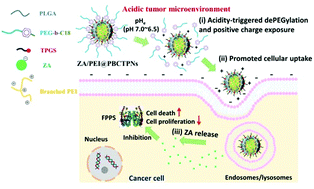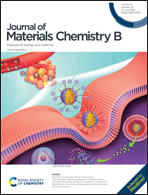Tumor acidity-responsive polymeric nanoparticles to promote intracellular delivery of zoledronic acid by PEG detachment and positive charge exposure for enhanced antitumor potency†
Abstract
Zoledronic acid (ZA), a third-generation bisphosphonate, has been extensively used to treat osteoporosis and cancer bone metastasis and demonstrated to suppress proliferation of varied cancer cells and selectively kill tumor-associated microphages (TAMs). However, the clinical applications of ZA in extraskeletal tumor treatment are largely restricted due to its rapid renal clearance and binding to bones. In this study, to promote intracellular delivery of ZA for amplified antitumor efficacy, tumor acidity-responsive polymeric nanoparticles with high ZA payload (ca. 12.3 wt%) and low premature ZA leakage were designed. As a pivotal material for surface coating, the acidity-sensitive and amphiphilic methoxy poly(ethylene glycol) (mPEG)-benzoic imine-octadecane (C18) (mPEG-b-C18) was synthesized by conjugation of mPEG-CHO with 1-octadecylamine upon Schiff base reaction. Through tailor-made co-assembly of the hydrophobic poly(lactic-co-glycolic acid) (PLGA), amphiphilic tocopheryl polyethylene glycol succinate (TPGS) and mPEG-b-C18 to encapsulate ionic complexes composed of ZA molecules and branched poly(ethylenimine) (PEI) segments, the attained therapeutic polymeric nanoparticles, characterized to have a hydrophobic PLGA/ZA/PEI-constituted core covered with mPEG-b-C18 and TPGS, were able to not only detach mPEG shielding upon acidity-triggered hydrolysis of benzoic imine bonds but also expose surface positive charges of protonated PEI segments. The in vitro cellular uptake and cytotoxicity studies demonstrated that the internalization of acidity-sensitive ZA-encapsulated nanoparticles by TRAMP-C1 mouse prostate cancer cells and murine macrophages RAW 264.7 was considerably promoted upon acidity-elicited PEG detachment and surface charge conversion, thus remarkably boosting intracellular ZA delivery and anticancer potency. Compared to PEG non-detachable ZA-loaded nanoparticles with poor tumor deposition and antitumor effect, the PEG-detachable ZA-carrying nanoparticles markedly accumulated in TRAMP-C1 solid tumors in vivo and inhibited tumor growth, thereby increasing the survival rate of the treated mice. The collective data suggest the great promise of tumor acidity-sensitive ZA-carrying hybrid nanoparticles in the treatment of extraskeletal solid tumors.



 Please wait while we load your content...
Please wait while we load your content...